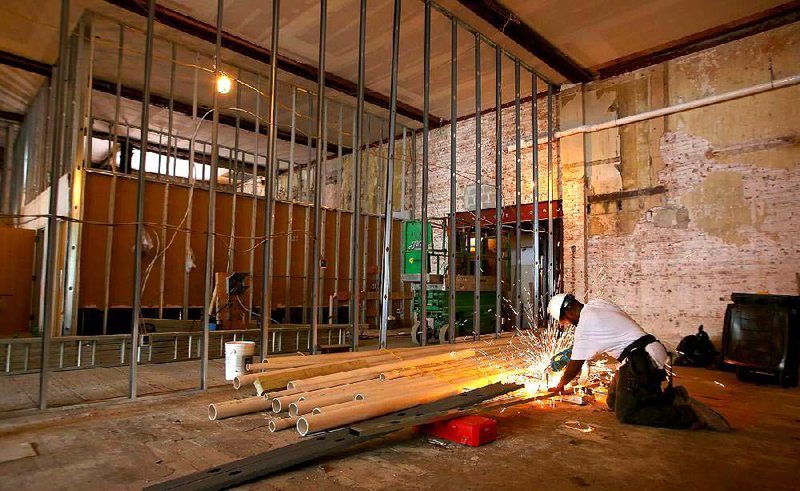Not long ago, commercial property for sale on and just off Main Street in Little Rock went begging.
But with private investment reaching about $68.5 million -- and the possibility of more -- sales records show that some properties in that area and beyond in downtown have seen double-digit percentage increases in price, according to an Arkansas Democrat-Gazette analysis of land records in the Pulaski County Tax Assessor's office.
Mayor Mark Stodola, long a champion of the Main Street effort, said that he is "ecstatic" about the swift build-out.
The number of downtown commercial properties sold in 2012 was double the rate sold during a 10-year period, the analysis shows.
In some cases, federal and state historic tax credits have made investment dollars go much further. The federal tax credit amounts to 20 percent of the cost of the restoration, plus another 25 percent under the state tax program.
In other words, up to 45 percent of the construction cost for a qualified project can be used as tax credits.
"You could leverage both the state and federal programs," said Mark Christ, spokesman for the Arkansas Historic Preservation Program. "We've seen a marked uptick in tax projects being done across the state" in the last five years. "Those two historic tax credits can make a historic rehabilitation feasible." The credits can also be converted into tradable instruments that will mean cash for investors.
Here is a list of projects in the Main Street corridor. Investment totals, which include the purchase of the buildings, were provided by the investors or sources close to the investors.
° Main Street Lofts, $11 million
° Aloft hotel, $18 million
° Capitol Lofts, $6 million
° K Lofts, $4.2 million
° Mann on Main, $23 million
° Five Main Place, $6.3 million. The renovation, which did not involve a purchase, was completed in December 2012 and was formerly the home of Stephens Inc. until the investment house bought the 25-story Rogers building and moved there.
The buildings -- except for Five Main Place -- have been long vacant, and their purchase prices reflected that.
The four buildings on the west side of the 500 block of Main were perhaps the best bargain -- and most intriguing example of the investment potential on the street. With a total of 240,000 square feet, they were bought in August 2012 by an investment group headed by Scott Reed of Portland, Ore., for $1.5 million from Tower Investments of Woodland, Calif., whose Lafayette Square project was stymied by the 2008 real estate downturn.
That's $6.25 per square foot.
The total appraised value of the four buildings in the 500 block was $4,256,900.
The group earlier this year sold the largest of the four structures, the 12-story Boyle Building, to an investor in its Capitol Lofts project for $4.6 million, after the costly removal of hazardous materials. The 91,000-square-foot building will become an Aloft hotel.
Purchase price per square foot: $50.55.
The downtown turnaround will get a boost from taxpayers as well.
City voters approved in 2011 a sales tax increase that will pay for a $22 million bond issue for a technology park, whose board has voted to build the facility in the Main Street corridor.
The funding will be less than half the amount needed to build the technology park, which carries an estimated price tag of $54 million for land acquisition and construction of office buildings.
The Main Street renaissance, thus far concentrated between Third and Seventh streets, follows the creation and continuing growth of the River Market District to the northeast.
Tom Ferstl, longtime Little Rock private appraiser, said he did valuation on just about all of the property in the River Market District during its creation in the mid-1990s.
In trying to value the property for Ottenheimer Market Hall, the center of what has become an entertainment district, Ferstl said he put the price at $2 a square foot.
An appraiser for the city thought the price was preposterously high, Ferstl recalled. But that was the price paid for the site, an old, crumbling building, he said.
It is too soon to see a land-price trend as a result of the massive infusion of capital on the property in the Main Street corridor, according to Ferstl. That will depend on the performance of the projects, he said.
But the farther the property is from the River Market District, the lower the price, an incentive for investment.
Recent sales of comparable properties, none of which have improvements, ranged from $78.45 per square foot in the River Market District to $20.62 at Sixth and Broadway.
The first sale in the Main Street resurgence was the former Gus Blass Department Store warehouse at 315 Main in November 2010 by the family of Dean Kumpuris, a city director, for a nominal amount, to investors led by Reed, Pulaski County court records show. Reed's group expects the K Lofts apartments to be on the market this summer. A club at and below street level has operated under three names. It is currently called Level.
The downtown rejuvenation has produced a nice profit. For example, The Rock Street Shops was bought by River Market South LLC, an arm of Moses Tucker Real Estate, in January 2007 for $849,000 and sold in January to McCain Lodging LLC, whose membership could not be ascertained, for $1.1 million, records show.
It seems these days that if there is a development plan for Main Street, it will move forward. But that was not the case recently.
A plan announced in 2006 to turn the Donaghey Building at Seventh and Main into 96 condominiums failed. The developer blamed the failure to buy a nearby parking deck from the Metrocentre Improvement District because the city, which owned the land beneath the deck, would not forgo payment for the property, which it valued at $1.1 million.
Sunday Business on 05/25/2014
